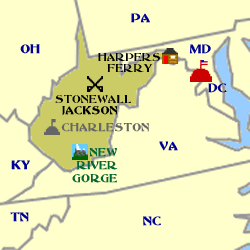West Virginia
From colonial times up to the Civil War this area was part of Virginia. The mountainous area in the north west of Virginia was inhabited by people mainly of Celtic or German origin who had a highly self sufficient way of life, many of whom abhorred slavery. In the rest of the state there were large plantations that were dependent upon slaves. On April 17, 1861 delegates from across Virginia voted for secession from the Union, but the majority of delegates from the area that now forms West Virginia voted against. Disquiet in the west with the decision to secede resulted first in setting up an alternative pro Union Virginia state government then in October 1861 there was vote in favour of setting up a new state, albeit on a low turnout. After lengthy negotiations over its constitution, West Virginia was admitted as a state on June 20, 1863. After the war Virginia went to the Supreme Court to try to regain its lost territory, but lost the case and West Virginia remains a separate state to this day.
State Capitol, Charleston
West Virginia took its time to sort out where to put its capital. The legislature met in both Wheeling and Charleston until in 1877 the people of West Virginia voted to make Charleston their capital. The first capitol opened in 1885 but burned in 1921. A second capitol was constructed but it burned down in 1927. It was a case of third time lucky after work on the current capitol began in 1924. It was designed by Ohio born Cass Gilbert who had achieved prominence by designing the world's first skyscraper, the Woolworth Building in New York City. The capitol was built in three stages, first the west wing, then the east wing and finally the two wings were connected by building the rotunda. The building was completed in 1932. The exterior is built of buff Indiana limestone and the copper dome is covered in gold leaf.
Carnegie Hall, Lewisburg
The name Carnegie Hall is often associated with New York, but steel baron Andrew Carnegie actually built several halls including one in his native Dunfermline in Scotland. In 1902 James Laing, a Lewisburg resident who hailed from Dunfermline, approached Carnegie regarding the replacement of a classroom block that had burned down. The $33,000 donated by the steel baron was used to build a Greek Revival building for the Lewisburg Female Institute, later known as the Greenbrier College for Women. In the 1980s the hall was saved from demolition by converting it into and arts and entertainment centre. Carnegie Hall is one of the grandest building in Lewisburg, but is far from the oldest. Built in 1770, The Barracks is the oldest building. It was used as an armoury during the War of 1812. Click Tab 2 to see The Barracks

Covered Bridge, Phillipi
The Philippi Covered Bridge was built across the Tygart River in 1852 as part of the construction of a new turnpike. It uses a Burr Arch Truss which combines an arch with a multiple king post truss, thereby for the first time allowing spans of more than 30 metres (100 feet). The Burr Arch Truss was patented by Theodore Burr of New York in 1804. Two additional piers were added to the Phillippi Bridge in 1934 to strengthen it. In 1989 the bridge was severely damaged by fire, but was restored in 1991. Apart from being unusually long at 87 metres (285 feet), it is the only covered bridge on a federal highway. Click Tab 2 to see a diagram of a Burr Arch Truss.
Aerial Tramway from Canyon Rim, Pipestem Resort State Park
The Cumberland Mountains in the southern West Virginia provide some fine mountain scenery. Deep in the mountains is Pipestem Resort State Park which was established in the 1960s on land surrounding the gorge of the Bluestone River. An aerial tramway takes you to the canyon rim down to the bottom of the gorge. Apart from its many trails with views across the mountains, the resort offers golf, fishing, horseback riding and swimming.

Click on Minimap to navigate




Seneca Rocks
A large quartzite rock outcrop in the eastern panhandle of West Virginia has become a magnet for rock climbers. There are many routes to climb the rocks with varying degrees of difficulty. The name of the outcrop comes from the Seneca Indians who lived on lands now in western New York State. They may have seen the rocks on their travels but they were never resident in the area. Click Tab 2 to see climbers on the rock

German Street, Shepherdstown
The oldest town in West Virginia sits on the bank of the Potomac River which forms the border between Maryland and West Virginia. Thomas Shepherd was given a land grant here in 1734. He built the town of Mecklenburg on part of the land and it was granted a charter in 1762. In 1798 the name was changed to Shepherd's Town after its founder but over time it became common to contract it to Shepherdstown. The shortened name was formally adopted after the Civil War. The town has retained many old buildings which form Shepherdstown Historic District, centred around German Street.
DLU110718


We have more pages on West Virginia. Click below or on the Minimap:

© Mike Elsden 1981 - 2023
The contents of this page may not be reproduced in full or in part without permission